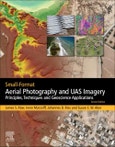Small Format Aerial Photography and UAS Imagery: Principles, Techniques and Geoscience Applications, Second Edition, provides basic and advanced principles and techniques for Small Format Aerial Photography (SFAP), focusing on manned and unmanned aerial systems, including drones, kites, blimps, powered paragliders, and fixed wing and copter SFAP. The authors focus on everything from digital image processing and interpretation of data, to travel and setup for the best result, making this a comprehensive guide for any user. Nine case studies in a variety of environments, including gullies, high altitudes, wetlands and recreational architecture are included to enhance learning.
This new edition includes small unmanned aerial systems (UAS) and discusses changes in legal practices across the globe. In addition, the book presents the history of SFAP, providing background and context for new developments.
Please Note: This is an On Demand product, delivery may take up to 11 working days after payment has been received.
Table of Contents
Part I. History and principles1. Introduction to small-format aerial photography 2. Basic principles of SFAP 3. Photogrammetry4. Lighting and atmospheric conditions5. Photographic composition
Part II. SFAP techniques6. Cameras for SFAP7. Manned and tethered platforms and mounts8. Unmanned aerial systems (UAS drones) 9. SFAP survey planning and implementation10. Legal issues11. Image interpretation12. Image processing and analysis
Part III. Case studies13. Gully erosion monitoring14. Wetland environments15. Architecture, archaeology, and cemeteries 16. Recreational property17. Vegetation and soils18. Wind energy 19. Vineyards 20. Geomorphology21. Emergence of SFAP








